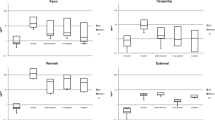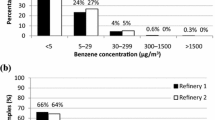Summary
A study was carried out among 20 workers employed in a printing, office at three different work places (methanol concentration: 85, 101, and 134 ppm) to determine whether the concentration of formic acid in blood or urine and the methanol content of alveolar air permit the estimation of methanol exposure.
For this purpose blood, urine, and end expiratory air were collected at the beginning and the end of the shift. For comparison formic acid concentrations were determined in the morning and in the afternoon in blood and urine of 36 and 15 control persons, respectively.
The concentration of formic acid in blood increased significantly from 3.2 ± 2.4 mg/l before to 7.9 ± 3.2 mg/l after the shift in the exposed workers (mean increase 4.7 ± 3.8 mg/l). The corresponding concentrations in urine were 13.1 ± 3.9 mg/l and 20.2 ± 7 mg/l, respectively, with a mean increase of 7.1 ± 5.3 mg/l. This difference is also significant. On the contrary, in the control groups there was a small but significant decrease of formic acid concentration in blood from 5.6 ±4.5 mg/l in the morning to 4.9 ± 4.2 mg/l in the afternoon. In urine, the formic acid concentrations in the morning (11.9 ± 6.4 mg/l) and in the afternoon (11.7 ±5.6 mg/l) were not significantly different. The increase of formic acid concentration in blood during the shift is the most useful parameter for monitoring methanol exposed persons. In contrast determinations of methanol concentrations in the ambient air or in the exhaled air are only crude estimates.
Similar content being viewed by others
References
Angerer, J.: Eine gaschromatographische Methode zur Bestimmung von Ameisensäure im Harn in Form von Kohlenmonoxid. Z. Clin. Chem. Clin. Biochem. 14, 73–77 (1976)
Angerer, J.: Gaschromatographische Bestimmung der Ameisensäure in Blut nach Überführung in Kohlenmonoxid. Mikrochim. Acta II, 405–412 (1977)
Angerer, J., Lehnert, G.: Occupational Exposure to methanol. Acta Pharmacol. Toxicol. 41 [Suppl. II] (Kbh), 551–556 (1977)
Angerer, J., Manz, A., Lehnert, G., Szadkowski, D.: Ameisensäureausscheidung im Harn und Methanolkonzentration in der Alveolarluft bei methanolexponierten Tiefdruckarbeitern. Med. Monatsschr. 31, 36–39 (1977)
Åstrand, J., Ehrner-Samuel, H., Kilbom, Å., Övrum, P.: Toluene exposure I. Concentration in alveolar air and blood at rest and during exercise. Work environm hlth 9, 119–130 (1972)
Browning, E.: Toxicity and metabolism of industrial solvents. pp. 311–323. Amsterdam, London, New York: Elsevier 1965
Di Vincenzo, G. D., Yanno, F. J., Astill, B. D.: Exposure of man and dog to low concentrations of acetone vapor. Am. Ind. Hyg. Assoc. J. 34, 329–336 (1973)
Dutkiewicz, T., Tyras, H.: The quantitative estimation of toluene skin absorption in man. Int. Arch. Gewerbepath. Gewerbehyg. 24, 253–257 (1968)
International Labour Office: Encyclopaedia of Occupational Health and Safety, Vol. II, pp. 879–880. Geneva 1972
Kane, R. L., Talbert, W., Harlan, J., Sizemore, G., Cataland, S.: A methanol poisoning outbreak in Kentucky. Arch. Environ. Health 17, 119–129 (1968)
Lauwerys, R.: Biological criteria for selected industrial toxic chemicals: A review. Scand. J. Work Environ. Health 1, 139–172 (1975)
Lehnert, G.: Arbeitsmedizinische Risikobeurteilung aus klinischer Sicht. Verhandlungen der Deutschen Gesellschaft für Arbeitsmedizin e. V. 17. Jahrestagung in Kiel vom 5.–7.5.1977: Arbeitsmedizinische Risikobeurteilung (Eignung und Tauglichkeit) S. 23–27. Stuttgart: Genter 1977
Mackenzie, C. G.: Formation of formaldehyd and formate in the biooxidation of the methyl group. J. Biol. Chem. 186, 351–368 (1950)
Malorny, G.: Die akute und chronische Toxizität der Ameisensäure und ihrer Formiate. Z. Ernährungswiss. 9, 332–339 (1969)
Malorny, G.: Stoffwechselversuche mit Natrium-formiat und Ameisensäure beim Menschen. Z. Ernährungswiss. 9, 340–348 (1969)
Malorny, G., Rietbrock, N., Schneider, M.: Die Oxydation des Formaldehyds zu Ameisensäure im Blut, ein Beitrag zum Stoffwechsel des Formaldehyds. Naunyn Schmiedebergs Arch. Pharmacol. 250, 419–436 (1965)
Monster, A. C.: Kinetics of chlorinated hydrocarbon solvents. Studies in volunteers exposed to trichloroethylene, 1,1,1-trichloroethane and tetrachloroethylene. Amsterdam: Thesis 1978
Monster, A. C., Boersma, G., Duba, W. C.: Pharmacokinetics of trichloroethylene in volunteers; influence of workload and exposure concentration. Int. Arch. Occup. Environ. Health 38, 87–102 (1976)
Nomiyama, K., Nomiyama, H.: Metabolism of trichloroethylene in human, sex difference in urinary excretion of trichloroacetic acid and trichloroethanol. Int. Arch. Arbeitsmed. 28, 37–48 (1971)
Pohl, J.: Über die Oxydation des Methyl- und Äthylalkohols im Tierkörper. Naunyn Schmiedebergs Arch. Pharmacol. 31, 281 (1893)
Schüppel, R., Soehring, K.: Vermehrte Ameisensäure-Ausscheidung — ein Maß für gesteigerte Demethylierungsvorgänge in vivo? Naunyn Schmiedebergs Arch. Pharmacol. 251, 109–110 (1965)
Szadkowski, D., Pett, R., Angerer, J., Manz, A., Lehnert, G.: Chronische Lösungsmittelbelastung am Arbeitsplatz II. Schadstoffspiegel im Blut und Metabolitenelemination im Harn in ihrer Bedeutung als Überwachungskriterien bei toluolexponierten Tiefdruckern. Int. Arch. Arbeitsmed. 31, 265–276 (1973)
Author information
Authors and Affiliations
Additional information
(Direktor: Prof. Dr. G. Lehnert)
Rights and permissions
About this article
Cite this article
Baumann, K., Angerer, J. Occupational chronic exposure to organic solvents. Int. Arch Occup Environ Heath 42, 241–249 (1979). https://doi.org/10.1007/BF00377778
Received:
Accepted:
Issue Date:
DOI: https://doi.org/10.1007/BF00377778




